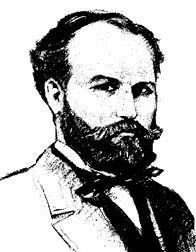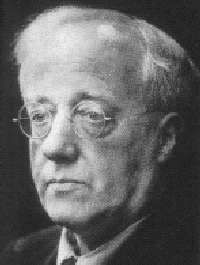This new fanfare for brass and percussion was written last year by Kevin Kaska for the Boston Symphony Orchestra's Campaign 2000 and was privately premièred November 22nd. As the title suggests, it is short, upbeat and brilliant and is written somewhat in the style of John Williams. It is scored for threesomes of horns, trumpets and trombones together with tuba, timpani and other percussion. Each group has a chance to shine in virtuoso style. SPM is proud to present the public world première of this exciting piece.
Sir Edward Elgar brought to a happy end the long drought of major native English composers since the time of Purcell. He was born in a small village near Worcester in the West of England and was happiest when living in that area, although the Elgars did have spells of living in London. Elgar came from a musical family, but had very little formal musical education - he was largely self-taught in piano, violin and bassoon. Like Holst, Elgar appeared to be destined for a solo career (violin) but decided against it when about twenty. In 1884, he played in a performance of Dvorak's sixth symphony, conducted by the composer and was enthralled. In 1889 he married a former pupil, Alice Roberts, one of whose poems he later set to music in Sea Pictures.
His reputation was established with the Enigma Variations in 1898 [performed by SPM a few years ago] followed the next year by his choral masterpiece The Dream of Gerontius. From that point on, nothing would stop his fame and fortune - he was the English maestro until his death, perhaps until the present day. He journeyed twice to the U. S: once to Yale and once to New York, in 1905 and 07 respectively.
The Serenade for Strings is a fairly early work and rather light by comparison with much of his other music. It is not as well known as its sibling, the Introduction and Allegro for Strings. There are three quite short movements arranged such that the last movement ends with a reprise of the first. Typical of his work, there is elegance and nobility in the music, but here it is also beautifully lyrical and touching.

Although Gounod began and ended his life in Paris, and was every bit the Frenchman, there is surprisingly an English connection, for he settled in London for four years at the time of the Franco-Prussian war, a few years before writing tonight's work. Though perhaps not one of France's best known composers, he nevertheless has earned a fixture in the operatic repertoire with Faust. He was born into an artistic family, learning the piano from his mother. He knew quite early that he wanted to become a musician and at 18, entered the Paris Conservatoire.
The Petite Symphonie is a charming piece for nine wind instruments (double wind quintet minus the second flute), full of wit and melody. In it, he adapts the manner of the Viennese school to delicate harmonies in the best French tradition.

Despite his foreign-sounding name, Gustav Holst was as English as, well, cricket or ale. His grandfather had emigrated from Sweden about thirty years before Gustav's birth. Together with his lifelong friend Ralph Vaughan Williams, he renewed interest in the use of English folk song.
I have to admit right here that I'm a big fan of Holst's music and regard him as one of the most undervalued composers. Although many music lovers may be hard-pressed to think of any of his music other than The Planets, and granted he was not a prolific composer by most standards, he did write a significant number of quality pieces, such as the Hymn of Jesus, the St. Paul's Suite, Savitri, Egdon Heath, The Perfect Fool and The Wandering Scholar. In addition, he arranged a good many familiar Christmas carols.
Gustav was born into a very musical family and showed early promise as a concert pianist. His father (also his teacher) did not encourage the boy to develop his passion for composition until neuritis in his right arm put a solo career out of the question. He started his professional career at age 17 as an organist and choirmaster near his home and the following year enrolled at the Royal College of Music, where he met Vaughan Williams. His chosen second instrument was the trombone, which helped cure his childhood asthma and later allowed him to support himself by playing in a number of different orchestras in the London area. After marrying (happily) in 1901, he became in 1905 the music director of St. Paul's girls' school, then in Hammersmith, West London, a post he held for the rest of his life. Boston audiences were able to hear him conduct his own music with the BSO during a six month stay as guest lecturer at Harvard during 1932.
The Planets first began to take shape in the spring of 1913 during a holiday in Mallorca in the Mediterranean, starting with Mars, in this case the harbinger of World War I. He finished the whole piece with Mercury in 1916 and the first performances were held in 1918 shortly before the end of the war. Popularity was immediate and it has remained a concert favorite ever since. The concept for the music was rooted in Holst's interest in astrology rather than astronomy - hence the omission of Earth and the yet-to-be-discovered Pluto, as well as the transposition of Mars and Mercury in the sequence. Although Holst was a lover of Wagner's music, The Planets owes a much greater debt to Stravinsky, especially The Rite of Spring - note the use of a large orchestra, including unusual instruments such as the bass oboe and bass flute, as well as the complex rhythms and undulating quiet passages used to evoke specific moods.
Mars, the Bringer of War is probably so familiar with its inexorable quasi-martial rhythm that it hardly needs an introduction. Anyone hoping for a quiet snooze is likely to be quite rudely awakened! Venus, the Bringer of Peace presents a complete contrast with its cold, stark beauty, indifferent to the petty squabbles of war. Mercury, the Winged Messenger has an ethereal, restless quality evoking the messenger, represented primarily by the woodwinds and celesta, flitting here and there, finally disappearing as unobtrusively as he appeared. This is followed by the other "big" number, Jupiter, the Bringer of Jollity, a succession of grand themes, climaxing in Holst's best-loved melody, later set to the words I vow to thee, my country. Incidentally, this hymn is a strong rival to Elgar's Land of Hope and Glory as the unofficial English National Anthem.
As we get farther out in the solar system, the character of the music gets noticeably stranger. In Saturn, the Bringer of Old Age, the unrelenting passage of time admits no exceptions - all are brought to judgment before the calm ending. Uranus, the Magician clearly has a lot of fun conjuring up his spells. There are similarities here with Dukas' Sorcerer's Apprentice, especially in the use of bassoon and contrabassoon. Neptune, the Mystic is the most visionary and impressionist of the movements including, as it does, an unseen female chorus. It depicts, as nearly as possible, the remoteness and mystery of this distant blue-green planet which had only been discovered about the time that Holst's grandfather arrived in England.